 |
The Runaway Mine
Train was Great Adventure's first major roller coaster, and though
considered tame by today's standards, it was the state of the art in
high thrills when it opened in 1974.
The ride's custom designed layout took it through (what was then) a
densely wooded area of the park, and along the scenic lake shore.
The interaction of the coaster with the trees, water, Skyride and Fort
structure made the ride more exciting and memorable. For
many children of the 1970's, the Runaway Mine Train will always be
remembered as their first "big" roller coaster. |
 |
| |
|
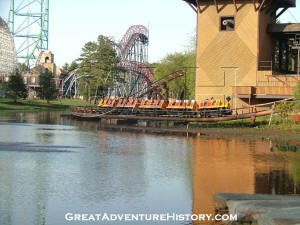 |
 |
| |
|
|
 |
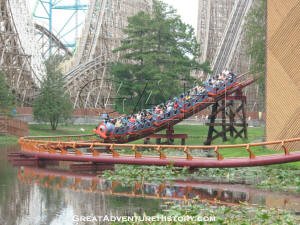 |
 |
| |
|
|
 |
The coaster was
custom designed for the park by Arrow Dynamics, one of the most prolific
builders of rides for theme and amusement parks during the 1960's, 70's
and 80's. Their revolutionary creation of tubular steel
track for the Matterhorn Bobsled ride at Disneyland ushered in the
modern steel coaster era, and they were pioneers along with Six Flags
corporation in the creation of the log flume ride.
Arrow was commissioned to create the Runaway Mine Train for Great
Adventure as well as the Log Flume. In later years Arrow
also designed the park's Hydro Flume, Lightnin' Loops and Great American
Scream Machine. |
 |
| |
|
 |
 |
| |
|
|
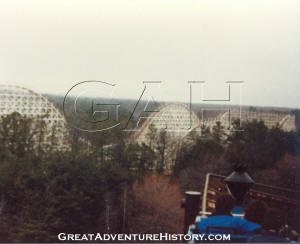 |
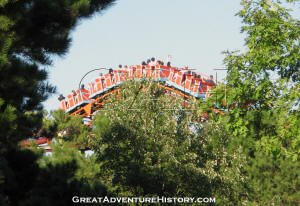 |
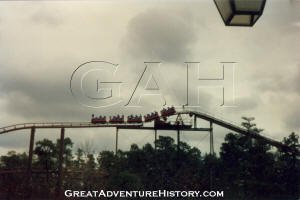 |
| |
|
|
 |
Unlike many other Arrow designed
mine train coasters, the Runaway Mine Train utilizes a single lift hill,
and ascends to a much higher point, where many of their designs remained
low to the ground and featured several stop and start points as trains
engaged multiple chain lifts over the course of the ride.
The large single lift hill allows the coaster to spend a good deal of
time high up in the trees for the first half of the ride, then swoops
low to the ground in the second half, plunging down to the lake level. |
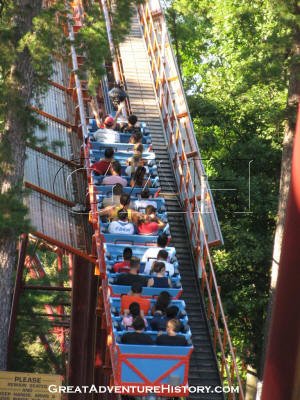 |
| |
|
|
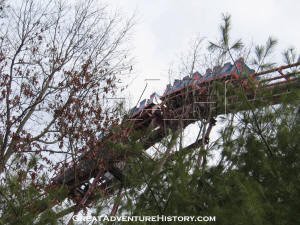 |
 |
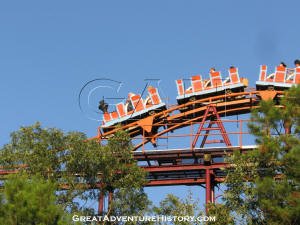 |
| |
|
|
 |
The coaster's steel
track runs through much of the course on steel columns. The
sections featuring the steel structure were originally out of the view
of guests, running through the wooded sections which were inaccessible
to guests.
The areas visible along the lake shore and the paths as the track comes
around the Fort and into the station were built with wooden supports,
adding to the rustic look of the ride.
Early in the testing stages of the Runaway Mine Train, the track was
partially re-profiled. According to a newspaper article:
"The
Runaway Train was
so wild we had to close it to take some of the bumps out of it. The
velocity goes up so fast you get jerked out of your car and we had a few
sprained necks."
The concept of the Runaway Mine Train went back to the earliest
conceptual plans for Great Adventure. Originally planned as
part of the park's Enchanted Forest area, the coaster was supposed to
have featured elaborate scenery along its course, with a plunge into the
mouth of a dragon. When plans for the park were scaled back,
the Runaway Mine Train was incorporated into the Rootin' Tootin' Rip
Roarin' section. Conceptual artwork showed the coaster
diving into a tunnel which was to run under the lake before remerging
near the station, but those plans were never realized due to time and
budget constraints. |
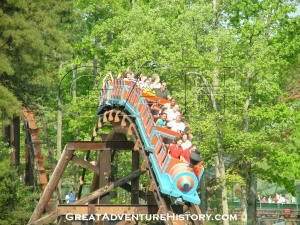 |
| |
|
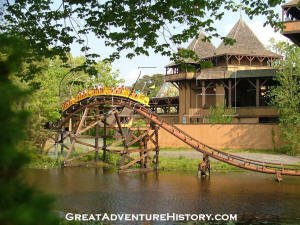 |
 |
| |
|
 |
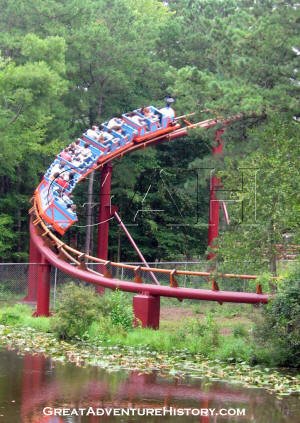 |
| |
|
|
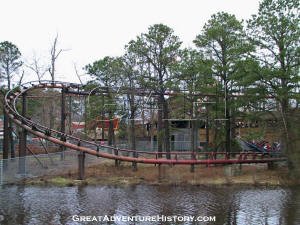 |
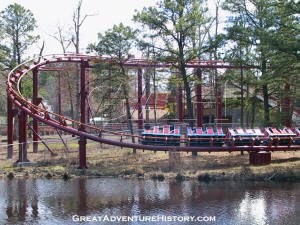 |
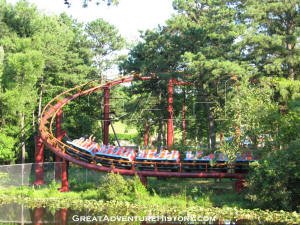 |
| |
|
|
 |
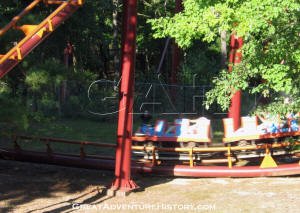 |
 |
| |
|
|
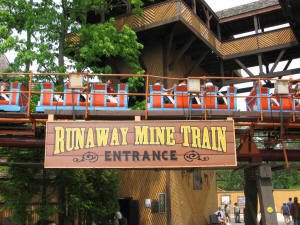 |
|
|
|
|
TECHNICAL INFORMATION |
|
|
|
|
Ride Name: |
Runaway
Mine Train |
|
Manufacturer: |
Arrow
Development |
|
Ride Model: |
Custom Mine
Train Coaster |
|
|
|
|
Installation Date: |
July 1974 |
|
|
|
|
Maximum Height of Track: |
60 feet |
|
|
|
|
Length of Track: |
2429 feet |
|
|
|
|
Number of Trains: |
Originally
4 with 3 operating at the same time |
|
|
Now 3 with
2 operating at the same time |
|
|
|
|
Cars per Train: |
5 |
|
Passengers per Car: |
6 (less two
in the front engine car) |
|
Passengers per Train: |
28 |
|
|
|
|
Safety Feature: |
Common locking lap bars modified |
|
|
to
individual lap bars for 2006 |
|
Height Requirement: |
44" tall |
|
|
|
|
Maximum Speed: |
38 MPH |
|
|
|
|
Braking: |
Originally
featured skid brakes later |
|
|
modified to
fin brakes |
|
|
|
|
Ride Time: |
2 minutes |
|
Theoretical Capacity: |
1000
guests/hour |
|
|
|
| |
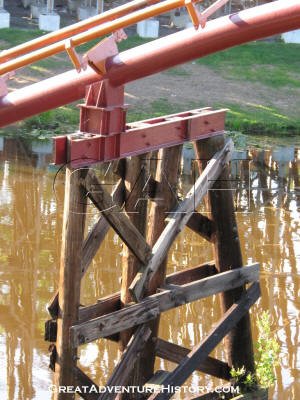 |
| |
 |
| |
|
|
 |
 |
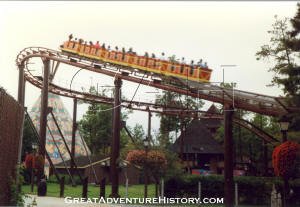 |
| |
|
|
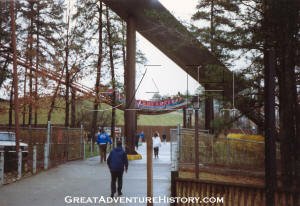 |
The Runaway Mine
Train was designed to operate with three trains, and was originally
equipped with four with one serving as a spare. The trains
were all painted in bright colors with two in orange and yellow, and two
in orange and blue. The trains alternated the two colors,
with two trains painted orange (one with blue trim, one with yellow) and
two trains with orange trim (one blue train and one yellow).
The alternating color schemes have remained the same since the ride
opened, though the fourth train (the yellow train with orange trim) has
been removed.
The coaster features a mid course brake run which is the flat section of
track between before the first drop to ground level into the third
helix. This brake run along with the station brake run both
feature rubber drive tires which can advance the train from a stop.
Those drive tires are also activated on cold day when the trains run
more slowly to give the trains a slight boost in speed so they are less
likely to stall. |
 |
| |
|
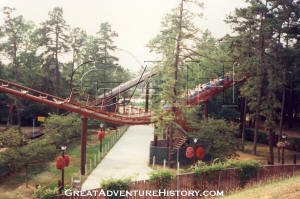 |
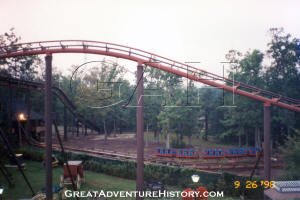 |
| |
|
 |
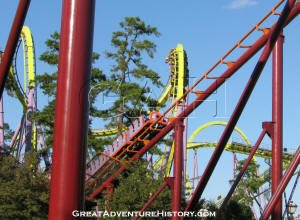 |
| |
|
|
 |
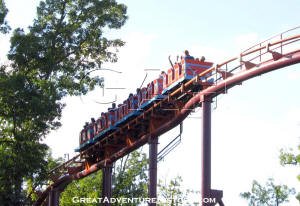 |
 |
| |
|
|
 |
 |
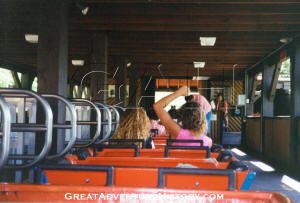 |
| |
|
|
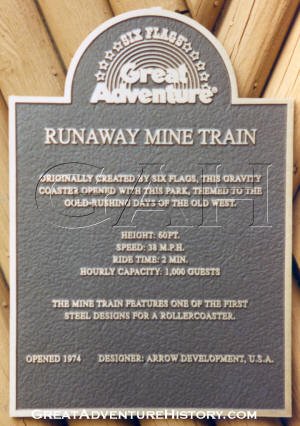 |
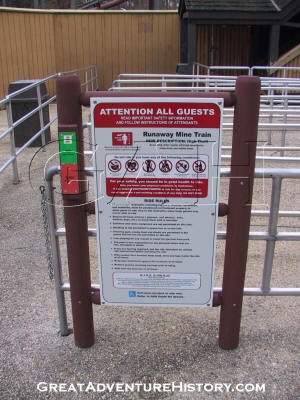 |
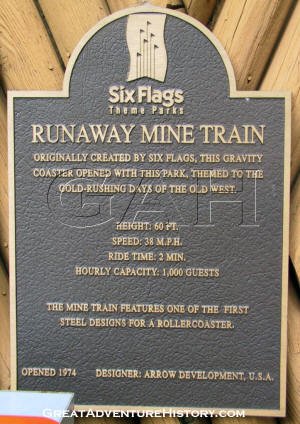 |
| |
|
|
 |
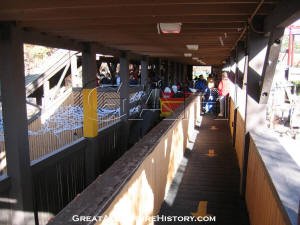 |
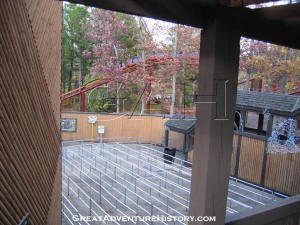 |
| |
|
|
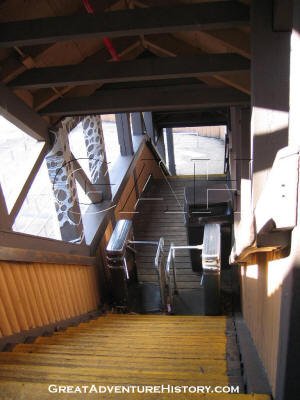 |
 |
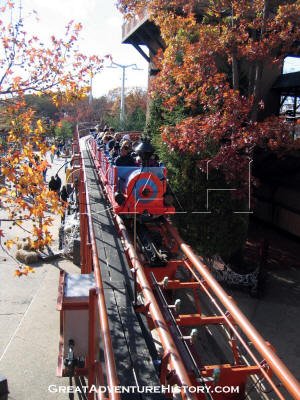 |
| |
|
|
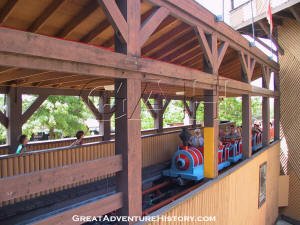 |
Over the years
several small modifications have been made to the ride.
The first and probably most important was replacement of the rides
original skid brake system with more modern fin brakes.
The skid brakes were very imprecise when it came to stopping the trains
at the proper point in the station, with trains frequently over or under
shooting the corrals. Also, skid brakes are more susceptible
to slipping in rain or other damp weather, and trains often would have
slight bumps when they would overshoot the station brake run, and tap
the train loading and unloading at the platform.
To help remedy the skid brake shortcomings, a set to heat lamps was
setup inside the station. the heat lamps were pointed upward
at the bottom of the train so when guests were loading and unloading the
brakes had a chance to dry off.
Another modification was in the station itself, where the the corrals
for waiting guests featured swinging saloon style doors.
These would eventually be replaced with the air gate system.
The ride's original lift motor has also been replaced with a more modern
energy saving variable speed motor. Rather than constantly
turning at full speed like the original, the new motor powers down to a
low speed until activated by sensors as a train approaches.
Once the train disengages the lift, the motor slows down to waiting mode
again. |
 |
| |
|
 |
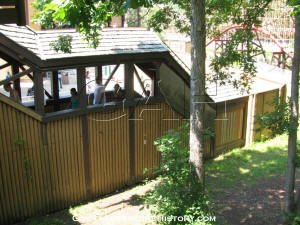 |
| |
|
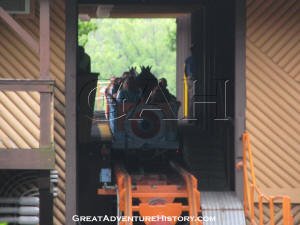 |
 |
| |
|
 |
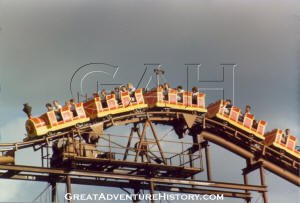 |
| |
|
|
Watch Video Of The
Runaway Mine Train
In Action:
 |
 |
| |
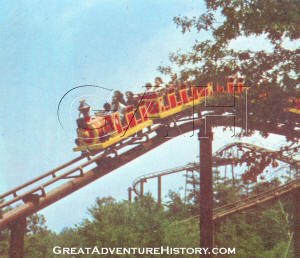 |
| |
|
|
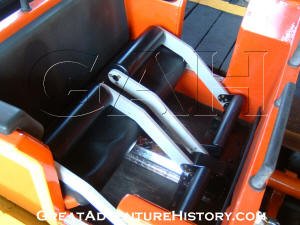 |
 |
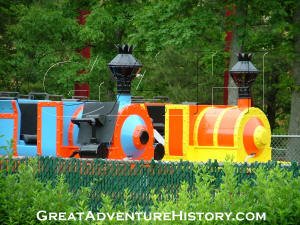 |
| |
|
|
 |
The coaster trains
have been modified over the years, first with the removal of some of the
decorative pieces. First removed were the trains'
headlights, which while never functional, added an extra touch to the
theme. Next was removal of some of the lead cars' decorative
cylinders.
The biggest modification happened in the 2005-06 off season, as the
trains old dual lapbars which operated as sets in each car were replaced
with individual lap bars. These new lapbars meant
that passengers could be secured individually rather than 6 at a time,
and offered a more comfortable ride for larger guests who often had
difficulty fitting in the older restraints. |
 |
| |
|
 |
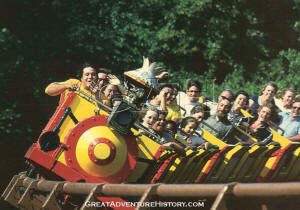 |
| |
|
|
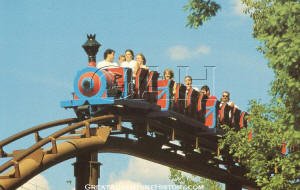 |
 |
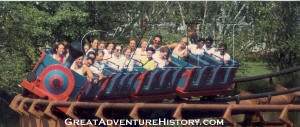 |
| |
|
|
 |
 |
 |
| |
|
|
 |
One of the most memorable parts of the Runaway Mine Train is its start
with an aerial double helix. The height and banking of the
spiral combined with the relatively open train design offer thrills, and
the famous head chopper support as the train leaves the helix always
makes rider duck.
The trains go into a dip before the mid-course brake run, which has
occasionally been a point where the train can saddle. After
an incident where a stuffed animal caused the train to get stuck in the
dip, an evacuation platform and stairs were added, as well as a stricter
"No stuffed prizes" policy for riders. |
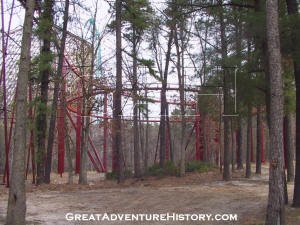 |
| |
|
 |
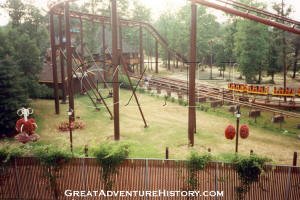 |
| |
|
 |
 |
| |
|
|
 |
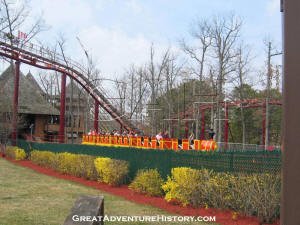 |
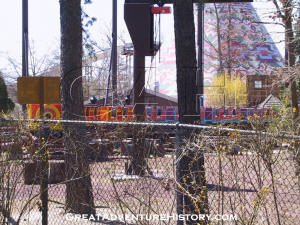 |
| |
|
|
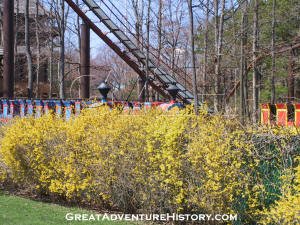 |
 |
 |
| |
|
|
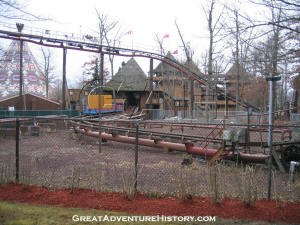 |
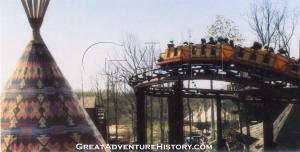

One of the more
unique aspects of the Runaway Mine Train is the train storage area which
sits on both sides of the track. There is enough storage
space for three trains in order to accommodate the original four trains the
ride was equipped with.
The photo on the lower right of a single car shows the arrival of the
first car and placement on one of the sidings.
|
 |
| |
|
 |
 |
| |
|
 |
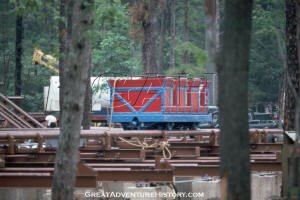 |
| |
|
 |
 |
| |
|
|
 |
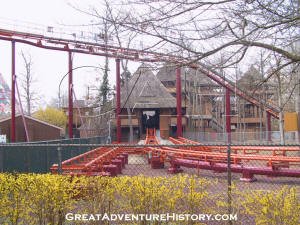 |
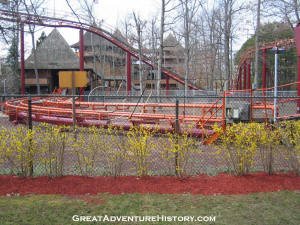 |
| |
|
|








